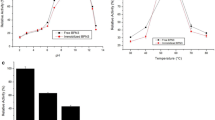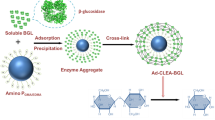Abstract
Alkaline polygalacturonate lyase (PGL), one of the pectinolytic enzymes, has been widely used for the bioscouring of cotton fibers, biodegumming, and biopulp production. In our study, PGL from Bacillus subtilis was successfully immobilized on the surface of polyhydroxyalkanoate (PHA) nanogranules by fusing PGL to the N-terminal of PHA synthase from Ralstonia eutropha via a designed linker. The PGL-decorated PHA beads could be simply achieved by recombinant fermentation and consequent centrifugation. The fused PGL occupied 0.985% of the total weight of purified PHA granules, which was identified by mass spectrometer-based quantitative proteomics. The activity of immobilized PGL (184.67 U/mg PGL protein) was a little lower than that of the free PGL (215.93 U/mg PGL protein). The immobilization process did not affect the optimal pH and the optimal temperature of the PGL, but it did enhance the thermostability as well as the pH stability at certain conditions, which will extend the practicability of the immobilized PGL-PHA beads in the alkaline and generally harsh bioscouring process. Furthermore, the immobilized PGL still retained more than 60% of its initial activity after 8 cycles of reuse. Our study provided a novel and promising approach for cost-efficient in vivo PGL immobilization, contributing to wider commercialization of this environmental-friendly biocatalyst.






Similar content being viewed by others
References
Boersema PJ, Raijmakers R, Lemeer S, Mohammed S, Heck AJ (2009) Multiplex peptide stable isotope dimethyl labeling for quantitative proteomics. Nat Protoc 4(4):484–494. doi:10.1038/nprot.2009.21
Blatchford PA, Scott C, French N, Rehm BH (2012) Immobilization of organophosphohydrolase OpdA from Agrobacterium radiobacter by overproduction at the surface of polyester inclusions inside engineered Escherichia coli. Biotechnol and Bioeng 109:1101–1108. doi:10.1002/bit.24402
Bradford MM (1976) A rapid and sensitive method for the quantitation of microgram quantities of protein utilizing the principle of protein-dye binding. Anal Biochem 72:248–254
Brockelbank JA, Peters V, Rehm BH (2006) Recombinant Escherichia coli strain produces a ZZ domain displaying biopolyester granules suitable for immunoglobulin G purification. Appl Environ Microbiol 72(11):7394–7397. doi:10.1128/AEM.01014-06
Bustamante-Vargas CE, de Oliveira D, Valduga E, Venquiaruto LD, Paroul N, Backes GT, Dallago RM (2016) Biomimetic mineralization of the alginate/gelatin/calcium oxalate matrix for immobilization of pectinase: influence of matrix on the pectinolytic activity. Appl Biochem Biotech 179(6):1060–1072. doi:10.1007/s12010-016-2050-7
Chen SY, Chien YW, Chao YP (2014) In vivo immobcion of D-hydantoinase in Escherichia coli. J Biosci Bioeng 118(1):78–81. doi:10.1016/j.jbiosc.2013.12.020
Chen GQ, Hajnal I, Wu H, Lv L, Ye J (2015) Engineering biosynthesis mechanisms for diversifying polyhydroxyalkanoates. Trends Biotechnol 33:565–574. doi:10.1016/j.tibtech.2015.07.007
Chiliveri SR, Linga VR (2014) A novel thermostable, alkaline pectate lyase from Bacillus tequilensis SV11 with potential in textile industry. Carbohyd Polym 111:264–272. doi:10.1016/j.carbpol.2014.04.065
Denner EBM, Mcgenity TJ, Busse HJ, Grant WD, Wanner G, Stan-Lotter H (1994) Halococcus salifodinae sp. nov., an archaeal isolate from an Austrian salt mine. Int J Syst Bacteriol 44:774–780
Fang S, Li J, Liu L, Du G, Chen J (2011) Overproduction of alkaline polygalacturonate lyase in recombinant Escherichia coli by a two-stage glycerol feeding approach. Bioresource Technol 102:10671–10678. doi:10.1016/j.biortech.2011.09.020
Hay ID, Du J, Reyes PR, Rehm BH (2015) In vivo polyester immobilized sortase for tagless protein purification. Microb Cell Factories 14:190. doi:10.1186/s12934-015-0385-3
Hooks DO, Rehm BH (2015) Surface display of highly-stable Desulfovibrio vulgaris carbonic anhydrase on polyester beads for CO2 capture. Biotechnol Lett 37(7):1415–1420. doi:10.1007/s10529-015-1803-7
Hooks DO, Blatchford PA, Rehm BH (2013) Bioengineering of bacterial polymer inclusions catalyzing the synthesis of N-acetylneuraminic acid. Appl Environ Microbiol 79:3116–3121. doi:10.1128/AEM.03947-12
Hooks DO, Venning-Slater M, Du J, Rehm BH (2014) Polyhydroyxalkanoate synthase fusions as a strategy for oriented enzyme immobilisation. Molecules 19:8629–8643. doi:10.3390/molecules19068629
Hoondal GS, Tiwari RP, Tewari R, Dahiya N, Beg QK (2002) Microbial alkaline pectinases and their industrial applications: a review. Appl Microbiol Biotechnol 59:409–418. doi:10.1007/s00253-002-1061-1
Jahns AC, Rehm BH (2015) Immobilization of active lipase B from Candida antarctica on the surface of polyhydroxyalkanoate inclusions. Biotechnol Lett 37(4):831–835. doi:10.1007/s10529-014-1735-7
Jahns AC, Haverkamp RG, Rehm BH (2008) Multifunctional inorganic-binding beads self-assembled inside engineered bacteria. Bioconjug Chem 19:2072–2080. doi:10.1021/bc8001979
Kim YJ, Choi SY, Kim J, Jin KS, Lee SY, Kim KJ (2016a) Structure and function of the N-terminal domain of Ralstonia eutropha polyhydroxyalkanoate synthase, and the proposed structure and mechanisms of the whole enzyme. Biotechnol J [Epub ahead of print]
Kim J, Kim YJ, Choi SY, Lee SY, Kim KJ (2016b) Crystal structure of Ralstonia eutropha polyhydroxyalkanoate synthase C-terminal domain and reaction mechanisms. Biotechnol J [Epub ahead of print]
Klug-Santner BG, Schnitzhofer W, Vrsanska M, Weber J, Agrawal PB, Nierstrasz VA, Guebitz GM (2006) Purification and characterization of a new bioscouring pectate lyase from Bacillus pumilus BK2. J Biotechnol 121:390–401. doi:10.1016/j.jbiotec.2005.07.019
Laemmli UK (1970) Cleavage of structural proteins during the assembly of the head of bacteriophage T4. Nature 227:680–685. doi:10.1038/227680a0
Li Z, Bai Z, Zhang B, Li B, Jin B, Zhang M, Lin F, Zhang H (2012) Purification and characterization of alkaline pectin lyase from a newly isolated Bacillus clausii and its application in elicitation of plant disease resistance. Appl Biochem Biotech 167:2241–2256. doi:10.1007/s12010-012-9758-9
Liu K, Zhao G, He B, Chen L, Huang L (2012) Immobilization of pectinase and lipase on macroporous resin coated with chitosan for treatment of whitewater from papermaking. Bioresource Technol 123:616–619. doi:10.1016/j.biortech.2012.07.074
Lopez NI, Pettinari MJ, Nikel PI, Mendez BS (2015) Polyhydroxyalkanoates: much more than biodegradable plastics. Adv Appl Microbiol 93:73–106. doi:10.1016/bs.aambs.2015.06.001
Parlane NA, Grage K, Lee JW, Buddle BM, Denis M, Rehm BH (2011) Production of a particulate hepatitis C vaccine candidate by an engineered Lactococcus lactis strain. Appl Environ Microbiol 77(24):8516–8522. doi:10.1128/AEM.06420-11
Peters V, Rehm BH (2006) In vivo enzyme immobilization by use of engineered polyhydroxyalkanoate synthase. Appl Environ Microbiol 72:1777–1783. doi:10.1128/AEM.72.3.1777-1783.2006
Pohlmann A, Fricke WF, Reinecke F, Kusian B, Liesegang H, Cramm R, Eitinger T, Ewering C, Potter M, Schwartz E, Strittmatter A, Voss I, Gottschalk G, Steinbuchel A, Friedrich B, Bowien B (2006) Genome sequence of the bioplastic-producing ‘Knallgas’ bacterium Ralstonia eutropha H16. Nat Biotechnol 24(10):1257–1262. doi:10.1038/nbt 1244
Rehman HU, Aman A, Silipo A, Qader SA, Molinaro A, Ansari A (2013) Degradation of complex carbohydrate: immobilization of pectinase from Bacillus licheniformis KIBGE-IB21 using calcium alginate as a support. Food Chem 139:1081–1086. doi:10.1016/j.foodchem.2013.01.069
Rehm FB, Chen S, Rehm BH (2016) Enzyme engineering for in situ immobilization. Molecules 21(10):1370. doi:10.3390/molecules21101370
Seyedarabi A, To TT, Ali S, Hussain S, Fries M, Madsen R, Clausen MH, Teixteira S, Brocklehurst K, Pickersgill RW (2010) Structural insights into substrate specificity and the anti beta-elimination mechanism of pectate lyase. Biochemistry 49:539–546. doi:10.1021/bi901503g
Solbak AI, Richardson TH, McCann RT, Kline KA, Bartnek F, Tomlinson G, Tan X, Parra-Gessert L, Frey GJ, Podar M, Luginbuhl P, Gray KA, Mathur EJ, Robertson DE, Burk MJ, Hazlewood GP, Short JM, Kerovuo J (2005) Discovery of pectin-degrading enzymes and directed evolution of a novel pectate lyase for processing cotton fabric. J Biol Chem 280:9431–9438. doi:10.1074/jbc.M411838200
Spiekermann P, Rehm BH, Kalscheuer R, Baumeister D, Steinbuchel A (1999) A sensitive, viable-colony staining method using Nile red for direct screening of bacteria that accumulate polyhydroxyalkanoic acids and other lipid storage compounds. Arch Microbiol 171:73–80
Saleem Z, Rennebaum H, Pudel F, Grimm E (2008) Treating bast fibres with pectinase improves mechanical characteristics of reinforced thermoplastic composites. Compos Sci Technol 68:471–476. doi:10.1016/j.compscitech.2007.06.005
Tan D, Xue YS, Aibaidula G, Chen GQ (2011) Unsterile and continuous production of polyhydroxybutyrate by Halomonas TD01. Bioresource Technol 102:8130–8136. doi:10.1016/j.biortech.2011.05.068
Thakur J, Gupta R (2012) Improvement of tea leaves fermentation through pectinases. Acta Microbiol Imm H 59:321–334. doi:10.1556/AMicr.59.2012.3.3
Tzanova T, Calafell M, Guebitz GM, Cavaco-Paulo A (2001) Bio-preparation of cotton fabrics. Enzyme Microb Tech 29:357–362. doi:10.1016/S0141-0229(01)00388-X
Yao YC, Zhan XY, Zhang J, Zou XH, Wang ZH, Xiong YC, Chen J, Chen GQ (2008) A specific drug targeting system based on polyhydroxyalkanoate granule binding protein PhaP fused with targeted cell ligands. Biomaterials 29(36):4823–4830. doi:10.1016/j.biomaterials.2008.09.008
Yuan P, Meng K, Luo HY, Shi PJ, Huang HQ, Bai YG, Yang PL, Yao B (2011) A novel low-temperature active alkaline pectate lyase from Klebsiella sp. Y1 with potential in textile industry. Process Biochem 46:1921–1926. doi:10.1016/j.procbio.2011.06.023
Yadav S, Yadav PK, Yadav D, Yadav KDS (2009) Pectin lyase: a review. Process Biochem 44:1–10. doi:10.1016/j.procbio.2008.09.012
Acknowledgments
This work was financially supported by the National Natural Science Foundation of China (No. 21306110, No. 21602171) and China Postdoctoral Science Foundation (No. 2015M582640). We offer our acknowledgment to both Prof. Alexander Steinbuchel and Prof. Guo-Qiang Chen for kind donation of plasmid pBHR68. Besides, we also thanked Prof. Bernd H. A. Rehm for providing us many suggestions for the granule purification as well as the quantification of immobilized protein.
Author information
Authors and Affiliations
Corresponding authors
Ethics declarations
Conflict of interest
The authors declare that they have no conflict of interest.
Ethical statement
This article does not contain any studies with human participants or animals performed by any of the authors.
Additional information
GanQiao Ran and Dan Tan contribute equally to this paper.
Rights and permissions
About this article
Cite this article
Ran, G., Tan, D., Dai, W. et al. Immobilization of alkaline polygalacturonate lyase from Bacillus subtilis on the surface of bacterial polyhydroxyalkanoate nano-granules. Appl Microbiol Biotechnol 101, 3247–3258 (2017). https://doi.org/10.1007/s00253-016-8085-4
Received:
Revised:
Accepted:
Published:
Issue Date:
DOI: https://doi.org/10.1007/s00253-016-8085-4




